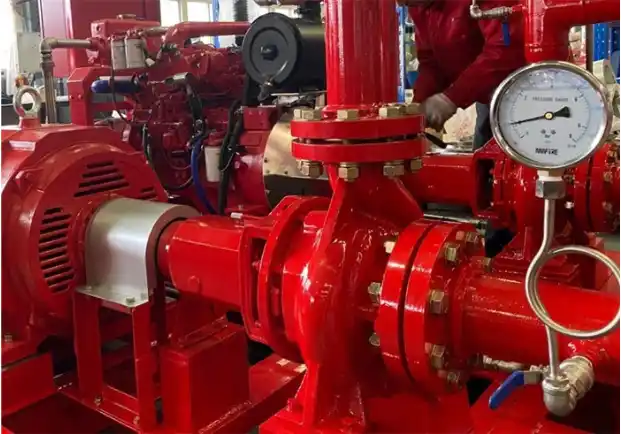Explanation of Fire Pump Installation and the Importance of Installing Them in Facilities

Fire pumps are one of the core pillars of safety and protection systems in facilities and buildings. They ensure rapid response in case of fire incidents, making their installation essential and mandatory for building owners. In many cases, installation is a regulatory requirement to comply with safety measures, which increases trust in the facility and enhances its value if it is ever put up for sale.
In this article, we will explain how fire pumps are installed, their importance, and the different types you can choose from depending on your facility’s needs.
Fire Pump Installation Explained
Below are the main steps involved in installing fire pumps:
- The installation process begins with a full site assessment to determine fire suppression needs, including facility size, room distribution, risk types, access points, and existing water systems.
- The required pressure for the fire suppression system is calculated based on the facility’s height and design, ensuring water reaches all points during a fire.
- The appropriate fire pump is selected according to site requirements. Options include electric pumps, diesel pumps, and jockey pumps, ensuring compliance with technical standards.
- A suitable location for installation is prepared, ensuring all technical and environmental requirements are met, such as ventilation and grounding connections.
- The pump is installed and connected with pipes, including mounting, water lines, and valves, with proper adjustments for reliable operation.
- Once installed, the pump and entire system are tested to verify effectiveness and emergency response readiness.
- To maintain system efficiency, a regular fire pump maintenance plan must be implemented, including inspections, cleaning, and replacement of worn parts.
Why Is Fire Pump Installation Important?
Fire pumps are vital components that protect both lives and property by providing the necessary water pressure to extinguish fires quickly and effectively, preventing fire spread and minimizing losses.
Moreover, many countries require the installation of firefighting equipment in buildings, following strict safety regulations and technical standards.
For this reason, engineers and building owners must apply these systems in line with approved technical requirements to ensure compliance and safety.
Basic Requirements for Fire Pump Installation in Residential Buildings
1- Choosing the Right Pump
Certified fire pumps must be used, compliant with both local and international standards to ensure efficiency in emergencies.
2- Selecting the Optimal Location
The pump installation site should be chosen carefully based on building design and fire system needs to ensure quick response during fire incidents.
3- Adjusting Capacity and Pressure
Pumps must provide adequate water flow and pressure to control fires effectively.
4- Ensuring Power Reliability
A reliable power source is required to ensure continuous pump operation without interruptions.
5- Performing Regular Inspections and Maintenance
A scheduled maintenance plan is necessary to keep the system in optimal condition and prevent failures.
Types of Fire Pumps and Their Features
Fire pumps are essential for delivering water with the required efficiency and pressure to combat fires. Their types vary depending on facility size and system requirements. The main types include:
1- Centrifugal Pumps
Used in large facilities and commercial complexes, these pumps draw water from a main source and distribute it through the fire protection network, ensuring broad coverage.
2- Portable Pumps
Ideal for outdoor events and temporary projects, these pumps are easy to transport and operate at multiple sites to meet emergency needs.
3- Vertical Pumps
Specifically designed for high-rise buildings, they provide consistent pressure to deliver water to upper floors without performance loss.
4- Inline Pumps
Featuring a modern design that blends seamlessly with building architecture, these pumps maintain technical performance while minimizing visual impact.
Which Is the Best Company for Fire Pump Installation?
- If you want to install fire pumps that meet the highest safety and quality standards, choose a leading company like Alsafi, with extensive experience in providing integrated fire protection systems—from site assessment to professional installation.
- Our qualified engineering team evaluates building layout, spaces, and risks to determine the best pump type—whether electric, diesel, or jockey—while ensuring global-standard quality implementation.
- Alsafi goes beyond installation by offering continuous technical support, routine maintenance, and system upgrades to ensure fire protection systems always operate at peak efficiency.
- If you’re looking for a trusted fire pump installation company with a specialized team, Alsafi is your best choice for safety and compliance. Don’t hesitate to contact us today.
In conclusion, fire pumps are essential installations in any building or facility. They ensure rapid response to fires, protecting both lives and property.
FAQs About Fire Pump Installation
Do fire pumps require regular maintenance?
Yes. Regular maintenance ensures readiness and efficient response in emergencies. Routine servicing helps check valves, pipes, and motors, ensuring quick response when needed.
What are the prices of fire pumps?
Prices vary depending on pump type, size, and capacity. These factors are essential in determining the final cost.
What are the best types of fire pumps?
There are several types available, including diesel pumps, electric pumps, and jockey pumps. Each type has unique specifications making it suitable for specific applications.



